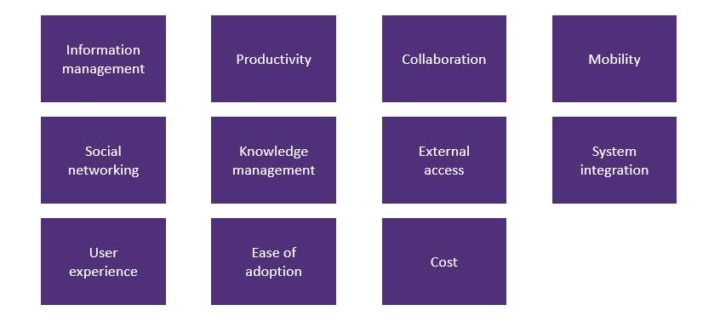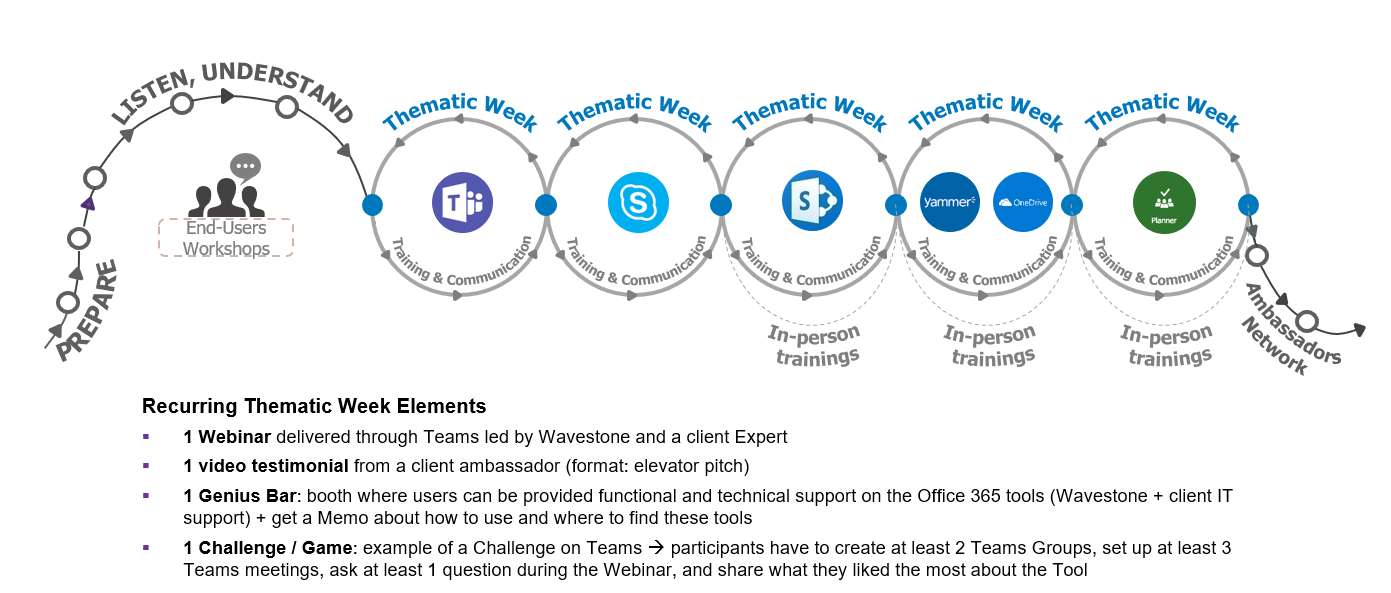Equipping your organization to embrace the digital experience for employees is more important than ever as companies compete not only in “what” to sell but also “how” to get there.
Why digital workplace transformation ?
Implementing new services and processes to enhance the work environment should be considered as part of overall organizational strategy rather than siloed IT department-driven initiatives. Digital technologies, such as business productivity solutions (e.g., Microsoft Office 365, Google G Suite), can help drive operational excellence and increase efficiency. Additionally, proactive adoption can even contribute to key competitive advantages such as branding and preferential access to talent.
At minimum, companies should invest in digital technologies in order to meet the increasing importance of the workplace in employee job satisfaction. According to the Dell & Intel Future Workforce Study:
- 82% of millennials consider workplace technology as a deciding factor when accepting a new job
- 42% of millennials state that they would consider quitting if the workplace failed to meet their expectations
Key success factors in digital workplace transformation
Innovative digital workplaces utilize evolutionary technologies in order to create a proper alignment between business processes, technology and employees. Significant business value, improved employee experience and enhanced IT performance are all results of adoption of these new technologies.
Digital workplace transformation provides several opportunities, but many companies face challenges when trying to realize the benefits. Major issues include user adoption, document management, governance and proper alignment. A user-centric approach must be taken in any digital workplace strategy, as each organization has its own unique requirements and business case. The set of capabilities and services offered should answer employee needs and foster an efficient working environment. A robust analysis should be performed to assess factors contributing to a solution’s functionality, usability, and ease of implementation.
Sample Tool Assessment Criteria
Identifying the right technologies is just one piece of the puzzle though, and equal focus must be given in defining the change management strategy.
Digital workplace transformation must be motivated by a concrete set of goals with measurable KPIs, such as adoption rate and employee satisfaction. Users’ real needs should be the driver behind the digital campaign, which should prioritize the populations and activities for which digital implementation would provide the most added value.
Engage leadership to communicate and champion the change. Focus should also be placed on key users who might not be in management positions but have the willingness and influence to increase user buy-in.
Engage users through a multi-channel campaign to maximize reach and efficacy. Materials should be tailored to the organization and focus on the key points users need to know in order to avoid “communication overload”. Keep in mind the multigenerational workforce and their varying needs.
- Users may feel intimidated and discouraged by new technologies if they believe change is constant. Overcome resistance by structuring communications to focus on opportunities for more effective working rather than ongoing change.
- Interactive activities, such as games, can let users interact with the tool, helping increase user engagement and retention of knowledge.
- Users should be given concrete examples of how the tools can be used to benefit their everyday activities.
Case study : Office 365 adoption for a large, multinational utility company
This organization had quickly grown following its acquisition of several companies and wished to increase productivity and collaboration across its teams (located in multiple locations) by deploying Office 365 in North America. Some applications (e.g., Skype) had experienced a high level of natural adoption; many tools, however, struggled to see greater use. Employees were unclear of the benefits of the less adopted applications and how they differed from existing solutions. For instance, OneDrive – Microsoft personal Cloud solution – and Teams – which centralizes all Teams’ information – adoption rates were very low. Additionally, users felt that technology changes were too frequent and that it was not worth learning a new software that would be changed soon.
Wavestone began by interviewing key stakeholders in the US headquarters (pilot study) to identify and prioritize the most important applications for which to increase adoption and utilization rate. Based on the gathered feedback, a customized strategy was defined and kicked off, starting with high-level communication helmed by leadership. More in-depth socialization and training were then implemented in a phased approach through “thematic weeks”, each dedicated to specific Office 365 tools. A continuous improvement approach was implemented by incorporating lessons learned from each iteration into subsequent thematic weeks. Simultaneously, special sessions were held with key influencers to help them better champion the digital solutions to the rest of the organization.
Phased Training Approach for O365 tool
Following successful implementation in the US headquarters, including a ~15% increase in Office 365 adoption and more than 20% increase in adoption of various applications after six weeks, the company decided to expand the strategy to its remaining offices in North America.
So what's next ?
The case for building a digital workplace is becoming increasingly crucial as organizations respond to market pressures to increase productivity while cutting costs and meeting employee workplace expectations. When assessing their employee digital experience, executives should consider the following:
Align digital workplace strategy with overall corporate strategy – What is our corporate strategy and what are our competitive advantages? Does our current employee digital experience support our larger goals?
- Does the current level of workplace digital maturity match our brand and company story?
- Who are the key employees we need to attract and retain? Does our digital workplace meet their expectations?
- Conversely, does the current organizational culture support our digital workplace strategy?
- What is our employee digital experience and what are the concrete objectives? How do we measure success?
- How do we ensure continuous improvement in our digital workplace strategy?
Identify the right services for your digital workplace – What are the best tools to help meet our digital workplace goals? Can we provide the proper use cases, features and quality for these services?
- What are our requirements and how do available solutions match up?
- Which vendors should we reach out to?
- Do the tools align with our other organizational requirements (e.g., cybersecurity, vendor risk)?
- What is the business case for the tool(s)? How do we prioritize which ones to invest in?
Implement change management strategy – How do we implement the digital workplace transformation in a way that would help us realize the desired benefits?
- Have we defined the appropriate governance to support the change? Who will be accountable for leading the change? Is there sufficient buy-in at the senior levels?
- Who (e.g., management, key users) will be communicating the changes? What is our message?
- Through what channels will the changes be communicated?
- How can we repeat and industrialize this process for future populations / tools?
- Have we provided sufficient training and materials for our employees to adopt the new tools?
In summary
The implementation of Digital Workplaces fosters collaboration between employees, improves the employee digital experience and enables the delivery of higher quality services to clients. Those developing an organization’s digital workplace strategy or executing the transition from previous services must focus on deploying the best solution in a secure manner.
Ultimately, a user-centric focus that encompasses all departments of an organization should be taken, treating the employee as the customer. It is with this end-user focused outlook that digital workplace transformations will drive operational performance, increase efficiency and contribute to competitive advantages!
This publication was produced with the contributions of Mathieu RUCH, Cécile OBEZ, and Araceli VALEZ.





